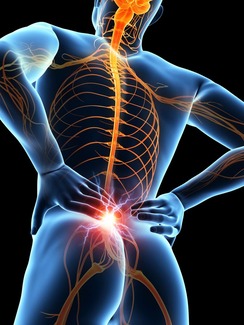
1. The neuroinflammation causing the nerve to react with a pain signal
2. The cause of the nerve injury or irritation
3. The muscles and joints that can keep the pain from coming back
To start the healing process we must address the inflammatory response around nerve. Here is the key point: we want to improve the response not block it. Many of the medications that are used during this stage block the nerve signal or inflammatory response all together slowing the healing process.
This leads to the question:
Is there something that can improve inflammation and speed healing?
In researching this question there appears to be a common answer.
Palmitoylethanolamide (PEA) is a compound naturally produced by your body in response to pain and inflammation. It specifically targets nerve inflammation and offers a nerve protection response. It has been said to help nerve pain patients heal much faster but what does it do?
Research shows improved pain and healing times for Sciatic nerve damage, carpal tunnel and thoracic outlet syndrome. 300-1200 mg/day Speeds pain relief and healing by over 50%.
Research Review CONCLUSION: (For those of you who wanted to skip through the studies anyway)
PEA is effective at treating nerve injury, pain and repair by changing the growth factors, cell function and inflammatory reaction at the cell level. PEA is specifically helpful for nerve compression such as sciatica, carpal tunnel and thoracic outlet syndrome as well as signs of fibromyalgia and neuropathic pain.
STUDIES:
Palmitoylethanolamide, a neutraceutical, in nerve compression syndromes: efficacy and safety in sciatic pain and carpal tunnel syndrome - PubMed (nih.gov)
In this research review on PEA of over 6,000 patients PEA was shown to be effective and safe to treat nerve compression syndromes of sciatic pain and carpal tunnel pain. In one double blind placebo control trial it reduced pain over 50% in sciatic patients in only 3 weeks.
Palmitoylethanolamide in Fibromyalgia: Results from Prospective and Retrospective Observational Studies - PubMed (nih.gov)
In this study patients taking PEA to address pain with fibromyalgia found improvements at 3 months and even greater at 6 months. They had less pain, tenderness and trigger points.
It works by addressing nerve inflammation and protection at the microglial cells. Microglial cells lead to peripheral and central sensitization and inflammatory and neuropathic pain because of the over-release of TNF-alpha and IL-1Beta. These neuromodulators are produced after injury or infection of peripheral and central nerves. This means that chronic pain is actually a result of imbalance in the immune system.
The immune system is activated to aid the nervous system when the microglial cells ask for help. The microglial cells are always surveying at the cellular level. When pathogens or injury are discovered, cytokines are released that call in the immune cells to clean up and fight off the pathogenic insult. This promotes an inflammatory response which creates neurotoxins. The neurotoxins in turn induce more inflammation. Without a good system to control the toxins produced during the treatment of the pathogen or injury to the nervous system, neuroinflammation will occur.
Efficacy of a fixed combination of palmitoylethanolamide and acetyl-l-carnitine (PEA+ALC FC) in the treatment of neuropathies secondary to rheumatic diseases - PubMed (nih.gov)
This study shows that in combination with Acetyl L-Carnitine, PEA was significant in improve pain and healing in sciatic and carpal tunnel syndrome. This shows that it may have a synergistic effect when combined with other nerve healing or analgesic compounds. Patients took 600 mg 2x/day for the first 2 weeks and then 1x/day for the remaining 6 months. Perhaps leading to and indication of doing a loading phase to further reduce pain.
Palmitoylethanolamide, a naturally occurring disease-modifying agent in neuropathic pain - PubMed (nih.gov)
PEA a member of the N-acylethanolamine family which is produced from the lipid bilayer on-demand, is capable of exerting anti-allodynic and anti-hyperalgesic effects by down-modulating both microglial and mast cell activity has led to the application of this fatty acid amide in several clinical studies of neuropathic pain, with beneficial outcome and no indication of adverse effects at pharmacological doses.
Non-neuronal cell modulation relieves neuropathic pain: efficacy of the endogenous lipid palmitoylethanolamide - PubMed (nih.gov)
PEA delayed mast cell recruitment, protected mast cells against degranulation and abolished the nerve growth factor increase in sciatic nerve concomitantly preserving the nerve from degeneration, while reducing microglia activation in the spinal cord. These findings support the idea that non-neuronal cells may be a valuable pharmacological target to treat neuropathic pain since the current neuronal-direct drugs are still unsatisfactory. In this context PEA could represent an innovative molecule, combining a dual analgesic activity, both on neurons and on nonneuronal cells.

 RSS Feed
RSS Feed